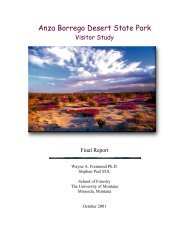Final Mitigated Negative Declaration and Response to Comments
Final Mitigated Negative Declaration and Response to Comments
Final Mitigated Negative Declaration and Response to Comments
Create successful ePaper yourself
Turn your PDF publications into a flip-book with our unique Google optimized e-Paper software.
XVI. TRANSPORTATION/TRAFFIC.<br />
ENVIRONMENTAL SETTING<br />
The Lake Tahoe Basin is located on the California-Nevada border in the Sierra Nevada<br />
Mountains. Principle access <strong>to</strong> the Lake Tahoe Basin is by vehicle via Interstate 80, by U.S.<br />
Highways 50 <strong>and</strong> 395, <strong>and</strong> by State Routes 28, 89, <strong>and</strong> 267. Driving time from Sacramen<strong>to</strong> is<br />
approximately two hours under favorable driving conditions. Winter s<strong>to</strong>rm events <strong>and</strong><br />
occasional l<strong>and</strong>slides can close highways or contribute <strong>to</strong> significant driving delays. State<br />
Route 89 on the edge of Emerald Bay State Park (SP) frequently closes during adverse winter<br />
weather due <strong>to</strong> snow avalanche danger. Major bus lines <strong>and</strong> railroad stations are located in<br />
Truckee <strong>and</strong> South Lake Tahoe. There are no direct commercial airline flights in<strong>to</strong> the Lake<br />
Tahoe Basin.<br />
The predominant mode of transportation used in the Lake Tahoe Basin is private vehicle<br />
(TRPA 2006). In the summer, there is considerable private vehicle traffic on the highways<br />
around the lake <strong>and</strong> at times traffic can become congested on these roads. The Tahoe<br />
Interregional/ Intraregional Transit Study <strong>Final</strong> Report (TRPA 2006) studied strategies <strong>to</strong><br />
exp<strong>and</strong> on surface (bus, rail, or waterborne) public transportation network connecting the North<br />
<strong>and</strong> South Shores, <strong>and</strong> connecting the Tahoe Region <strong>to</strong> nearby urban areas.<br />
Streets <strong>and</strong> Highways<br />
State Routes 28 <strong>and</strong> 89 <strong>and</strong> U.S. Highway 50 encompass the perimeter of Lake Tahoe. These<br />
main travel corridors can experience high traffic volume from private vehicles during portions of<br />
the year.<br />
Road Traffic <strong>and</strong> Level of Service<br />
Level of Service (LOS) measures how the route operates during peak hour traffic. LOS<br />
summarizes the effects of speed, travel time, traffic interruptions, freedom <strong>to</strong> maneuver <strong>and</strong><br />
other fac<strong>to</strong>rs. The performance of the county roads <strong>and</strong> highways is evaluated based on LOS<br />
definitions. Six levels of service represent varying roadway conditions ranging from ideal (LOS<br />
"A") <strong>to</strong> forced flow (LOS "F"). The areas of congestion are the intersections of Highway 50 <strong>and</strong><br />
Highway 89 in South Lake Tahoe <strong>and</strong> in Tahoe City at the intersection of Highway 89 <strong>and</strong><br />
Highway 28.<br />
Level Of<br />
Service (LOS)<br />
A<br />
B<br />
C<br />
Description of Typical Traffic Conditions Delay Service<br />
Rating<br />
Highest quality of service. Free traffic flow, low None Excellent<br />
volumes <strong>and</strong> densities. Little or no restriction on<br />
maneuverability or speed, <strong>and</strong> a high level or<br />
comfort <strong>and</strong> convenience.<br />
Stable traffic flow – speed becoming slightly None Very Good<br />
restricted; the presence of others in the traffic<br />
stream begins <strong>to</strong> be noticeable. Low resistance<br />
on maneuverability.<br />
Stable traffic flow, but less freedom <strong>to</strong> select Minimal Good<br />
speed, change lanes or pass. Comfort <strong>and</strong><br />
68<br />
Asian Clam Control Project IS/MND<br />
Emerald Bay State Park<br />
California Department of Parks <strong>and</strong> Recreation
















